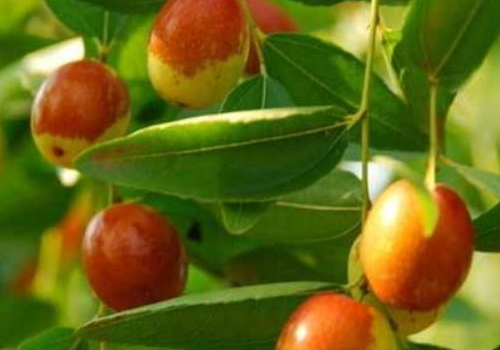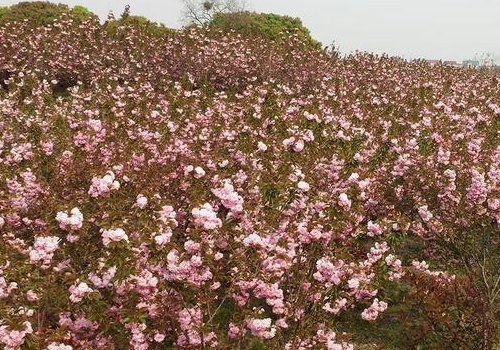What's the name of the bug on the jujube tree? can it be grafted?
So many of you know what this means, and many of you know what this means. Can it be grafted:
What is the name of the insect on the jujube tree?
The insects on jujube trees are called thorn moth larvae. A common name for the Lepidoptera family of insects, there are about 500 species. Worldwide, mostly tropical. Larvae fat short, slug-like. No abdominal feet, replaced by suckers. They don't crawl, they glide. Some larvae are bright in color, and their appendages are densely covered with brown prickly hair, like messy hair. When cocooning, their appendages extend out of cocoons for protection and camouflage. When disturbed, it stings people with poisonous stings and causes rashes. Feeding on plants. Pupation occurs in ovoid cocoons attached to leaves. Thorn moth larvae are often called Vitex tibetica, called neck silk hair in the northeast, and called Ya pot for cocoon. Eastern Shandong dialect is known as the Zi Mao, eight street Zi Mao. In case of sting, do not scratch with your hands, should immediately use wide tape repeatedly in the wound paste---tear off, can quickly remove most of the poison hair.

Can trees be grafted:
Date trees can be grafted. There are three main grafting methods for jujube trees:
1. Abdominal grafting: Take the scion that has been sealed with wax, and cut the scion into two opposite surfaces with a long surface of about 3 cm and a short surface of about 2 cm. selecting a smooth surface at the grafting part of the rootstock, obliquely cutting a cut downward by using pruning shears, wherein the angle between the cut and the vertical axis of the rootstock is about 15 degrees, and the length of the cut is equivalent to that of the scion long surface; inserting the scion long surface inward and the scion short surface outward into the rootstock cut, and aligning the scion and the cambium of the rootstock. Then cut the stock at about 0.8 cm above the interface, and tie the interface and the cutting surface at the top of the stock tightly with plastic strips to prevent the scion from loosening and losing water. This method is simple and easy to operate, grafting survival rate is high. The optimum rootstock diameter is 0.7~2 cm.
2. Splitting: Take the scion that has been sealed with wax, cut the scion into two equal inclined planes, and the inclined plane is 3~5 cm long. Cut off the upper part of the rootstock first, trim the cut smoothly, split it from the center of the rootstock with a cleaver or scissors, 5~7 cm deep, insert the cut scion, align the cambium of the scion and rootstock, and tie the interface tightly with plastic strips. This method is suitable for thicker rootstocks.
3. Skin connection: also known as subcutaneous connection. Take the scion that has been sealed with wax and cut the lower end into a smooth section of 3~5 cm long. Gently cut the back of both sides of the cut surface to expose the cambium, and then cut a short inclined plane of 0.5 cm long on the back of the lower end of the long cut surface for easy insertion. Select smooth place shear anvil, trim flat section. Cut a vertical opening on one side of rootstock with a knife, reaching deep into xylem, and cut the upper cortex and xylem with a knife. When inserting scion, insert the long cut face inward and the small cut face outward, facing the slit and slowly inserting downward. Tie tightly with plastic strips. This method is suitable for thicker rootstocks, that is, rootstocks with a diameter of more than 2 cm.
The name of the insect above the jujube tree was introduced here. The jujube tree could be grafted.
What is the name of the insect on the jujube tree?
Jujube is a fruit tree with strong adaptability, which causes drought and drought tolerance, so it is easy to plant. However, jujube trees will also affect the yield because of some late management work, pests are one aspect. Because of the characteristics of jujube trees, it will attract some special insects to wantonly destroy them.
What is the name of the insect on the jujube tree?
The insects on jujube trees are called thorn moth larvae. A common name for the Lepidoptera family of insects, there are about 500 species. Worldwide, mostly tropical. Larvae fat short, slug-like. No abdominal feet, replaced by suckers. They don't crawl, they glide. Some larvae are bright in color, and their appendages are densely covered with brown prickly hair, like messy hair. When cocooning, their appendages extend out of cocoons for protection and camouflage. When disturbed, it stings people with poisonous stings and causes rashes. Feeding on plants. Pupation occurs in ovoid cocoons attached to leaves. Thorn moth larvae are often called Vitex tibetica, called neck silk hair in the northeast, and called Ya pot for cocoon. Eastern Shandong dialect is known as the Zi Mao, eight street Zi Mao. In case of sting, do not scratch with your hands, should immediately use wide tape repeatedly in the wound paste---tear off, can quickly remove most of the poison hair.
Damage characteristics of jujube pests
1. Green bug. Harm and symptom: adult and nymph prick host bud, tender leaf and flower bud. The injured leaves and buds showed chlorotic spots at first, and with the extension of leaves. The dots gradually become irregular holes. After the bud is damaged, the development stops, dies and falls off, and almost all of the jujube flowers that are heavily damaged fall off, seriously affecting the results.
2. Flying elephant. Adults eat buds and leaves, often eat jujube buds, the second to third batch of buds can grow branches and leaves, weaken tree vigor, delay growth, reduce yield and quality. Larvae live in the soil and damage underground tissues of plants.
3. jujube madness. Also known as witches broom disease, pathogens for mycoplasmas. The disease can be transmitted both above and below ground, mainly through grafting and leafhoppers. Dry soil, barren, poor fertilizer and water conditions, extensive management, serious diseases and insect pests, weak tree vigor and heavy disease; saline-alkali land rarely disease. After the disease, jujube normal physiological disorder, hormone imbalance, leaf yellowing, twigs cluster, winter does not wither, pistil sometimes become twigs or leaflets, fruit deformity. Root disease, root tillers were also clustered.
The method of removing pests from jujube trees
1. Peach fruit borer. They're called maggots. Prevention and control methods: First, dig cocoons, soil thaw around the trunk of the topsoil will be opened, so that cocoons exposed to the surface, after the wind frozen and died. The second is to cover the ground around the trunk in spring to inhibit larval emergence, pupation and eclosion. Third, drug control in late July to early August spraying enemy kill for prevention and control.
2. Date slime worm. Baths are called leaf rollers. The main damage jujube buds, leaves, buds, flowers and fruits.
Prevention and control methods: First, early spring to scrape bark, and burn it. Second, in early September, tie straw stalks below the branches of the trunk, trap and kill the third generation mature larvae, remove the harrow after falling leaves, scrape off the cocoons attached to the bark, and burn them in a concentrated manner. Third, at the peak incubation period of jujube larvae with bud length of 3cm, dichlorvos, deltamethrin and other pesticides were sprayed to control them.
3. Date elephant shell. Also known as flying elephant. Eating jujube buds exclusively causes a decrease in production. The control measures were spraying Zaochongjing in late April to kill jujube weevil at its peak eating period.
The basic points of jujube pest control
1. First of all, symptomatic medication should be given. Accurately select which drugs to choose, according to the types of plant diseases and insect pests, select pesticide varieties with excellent control effect, and pay attention to the selected pesticides, which are safe and harmless to crops, or basically harmless to humans and livestock, and highly effective, low toxicity and low residue pesticide varieties that are pollution-free or basically pollution-free to the ecological environment.
2. Medication should be timely and timely. It should be used during the prevention period and the initial occurrence period of pests and diseases, so as to truly prevent diseases and diseases from being taken advantage of and causing harm.
3, the use of concentration should be reasonable. It is necessary to ensure the safety of crops, prevent phytotoxicity, and effectively eliminate pests and weeds. It is strictly prohibited to increase the concentration without experiment, which not only increases the cost of prevention and control, but also causes phytotoxicity and causes significant economic losses.
4, spray should be careful, careful, do not miss spray, do not repeat spray. In order to avoid incomplete control, causing re-development of pests or phytotoxicity.
Although jujube fruit rate is very high, but also because of other factors will produce some diseases and insect disasters, very common is what we say here caterpillar, will damage jujube leaves. Therefore, we should strengthen the prevention and control of jujube pests at ordinary times, so as to make jujube grow healthier.
- Prev

Jujube trees are planted for several years before they bear fruit. How many years is the life span?
Jujube trees, as many people know, can generally be seen by the roadside, so how many years do jujube trees grow before they bear fruit? How many years is the life span: jujube trees are planted for several years before they bear fruit: jujube seedlings usually bear fruit in the second year after planting. As the saying goes, peaches, plums, pears, walnuts, persimmons, and mulberry can feed silkworms in seven years.
- Next

How do Japanese evening cherry cuttings propagate and blossom for a few months
Japanese evening cherry, which is known to many people, is liked by many people, so how do Japanese evening cherry cuttings propagate? Blossom in a few months: how do Japanese late cherry cuttings propagate: 1. Selection and treatment of cuttings. Cut the sturdy branches, about 15 cm long, with current year's new shoots at the top.
Related
- Fuxing push coffee new agricultural production and marketing class: lack of small-scale processing plants
- Jujube rice field leisure farm deep ploughing Yilan for five years to create a space for organic food and play
- Nongyu Farm-A trial of organic papaya for brave women with advanced technology
- Four points for attention in the prevention and control of diseases and insect pests of edible fungi
- How to add nutrient solution to Edible Fungi
- Is there any good way to control edible fungus mites?
- Open Inoculation Technology of Edible Fungi
- Is there any clever way to use fertilizer for edible fungus in winter?
- What agents are used to kill the pathogens of edible fungi in the mushroom shed?
- Rapid drying of Edible Fungi

